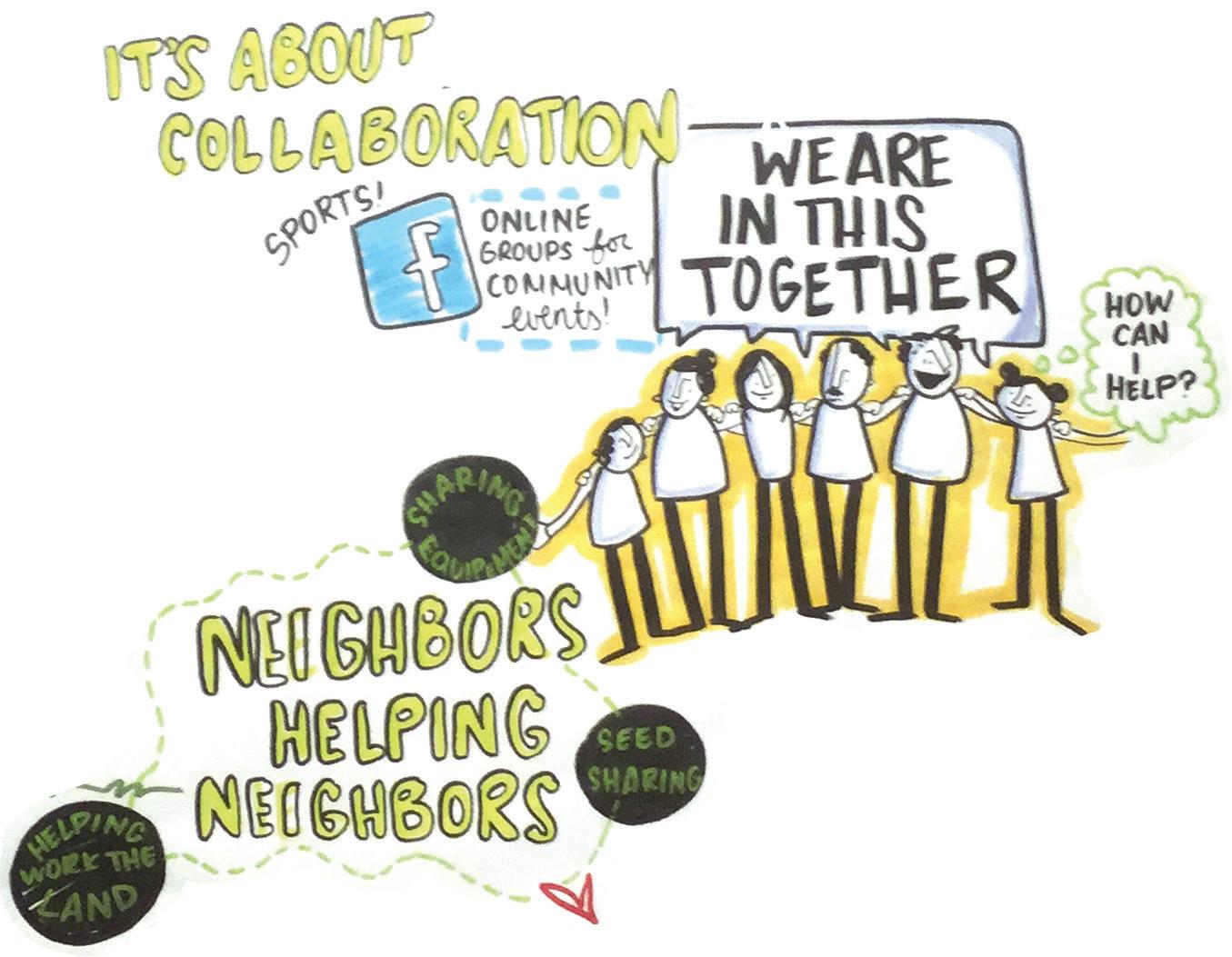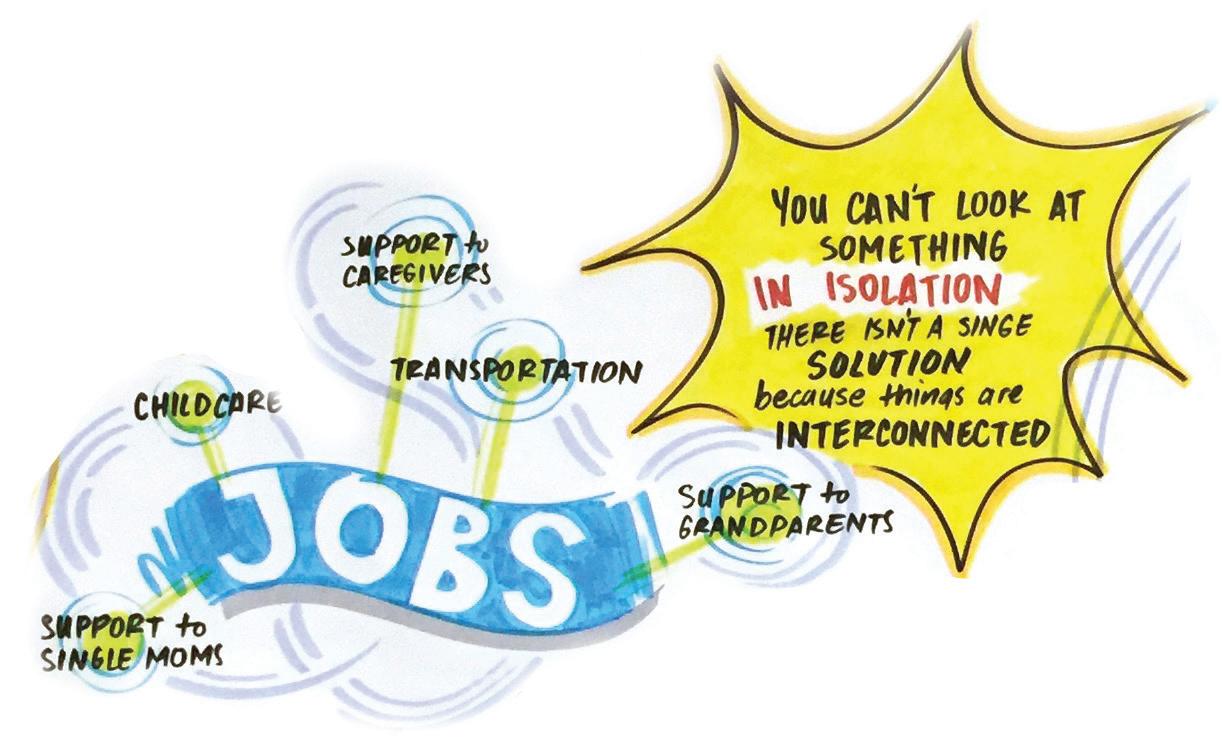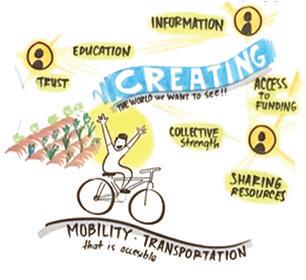
5 minute read
What we learned about How change happens
Manyof the insights we gained in this listening tour are insights that shed light on the power of people and the challenges they face due to our current system. Throughout our work over the years as conveners, listeners, facilitators, hosts, and believers in social change, we have some thoughts about how change happens, which were augmented by this listening tour. As a part of the this narrative, we intend to shed some light on what we’ve learned about how change happens.
Across the U.S. people are standing up for health because they can and because they must. Their own health challenges may have forced them to their knees. Concern for someone they love may have kicked them into action. A new insight may have opened a window on a possible future that had been invisible before. They somehow found a starting point.
I was in juvenile justice for seven years. Looking back, it’s been my college experience. Once you’re a criminal you’re not always one. Self education and self knowledge superside. I was alone from when I was 12. I got discharged when I was 25. I had no services or support system. But I wanted to change myself so bad. One day I was walking in this park and had a vision to do for others what I had lacked. A mentor taught me how to control my anger. I’m seen as a quiet leader who has the ability to draw people towards me and I support them.
Askari, Community Organizer, California
They muster whatever confidence and courage they can and they turn to those who will join them on the journey.
A place -- a particular piece of ground, a building, or a whole community -- becomes their field of practice. They begin and they learn. They start where they see the most need the greatest opportunity. Their initiatives often grow and expand quickly beyond the initial scope as they take action and learn what else is possible.
People show up in many different roles. Some are organizers of community. Others have deep knowledge and expertise in a certain area.

Our darkness started with my son getting his appendix taken out. The doctor handed me the pain meds and I did not question him. I handed them to my son. Two years later he was still on them. He is in recovery now. My vision is to create a place for people in recovery to find meaningful things to do, community that supports you and loves people out of their darkness.
Mary, Oklahoma
One person is a catalyst for change. Another connects the system with itself and makes sense of the patterns. One person returns after a long time away while someone else shows up as a newcomer -- both bring insights and experience from “away.” Still another works at a much more for intimate level, helping people navigate the systems that surround their lives. Sometimes they start alone and move forward through sheer force of will. Most of those who stay in it for the long haul turn to others for support, guidance, labor, and eventually co-ownership. It does take a village to create a culture of health.
Often they have little or no structural authority. No one else told them they could or should do what calls them. Almost always they started with no money. They asked others for help because, dammit, it’s the right thing to do. They shared stories and ideas and models. Even if they wanted to, they could not compel others to do anything, so they had to work with the powers of invitation and attraction rather coercion.
took two hours each way. They could be overwhelmed by the immensity of the challenges they see, and sometimes are. But they can’t give up. Lives are at stake. Their community is at stake. Their home.

They find a place to begin. Often they concentrate on one part of the puzzle -- but they are ready and willing to follow it wherever it might take them. The work of Grand Nation in Vinita, Oklahoma, began with a focus on drug abuse. Quickly they realized they needed to support people in living their whole, complex lives in ways that are healthy. They keep from being overwhelmed by focusing on one thing at a time. They keep from being ineffective by seeing the deep connections that weave together all aspects of life.
No one taught these folks to be systems thinkers and most would likely shrug at the term. But because they are working in the living web of community, they know that everything is interconnected -- obesity, transportation, economy, nutrition, stress, trauma, diabetes, drug abuse, exercise, medical care, incarceration, and more. How? Because their cousin is in prison for cooking meth after he lost his job because he was too overweight to walk that far and public transportation n We start with whatever is most real for the community. We start where people are, not where we want them to be. Working with what people themselves care about most -- rather than what some outside expert says is most important -- begins to rebuild the fabric of community. n While changes can be imposed from the outside with funding and mandates from external public and private authorities, nothing really catches on or lasts until community itself has its fingerprints all over it. When communities have ownership of what they are doing, they’ll change it when it doesn’t work and improve it when it does. n The greatest disease is disconnection. There is disconnection within communities, between generations, people of different ethnic or economic backgrounds. Disconnection exists within organizations, where work in silos causes wasteful use of resources. n The greatest disconnection is between those with formal decision making power and those affected by those decisions. Connecting people locally and translocally in conversations that matter, sharing questions and stories and wisdom and models seeds cultural shift. n This work is not carried out according to some masterplan. We make the path by walking it, guided by a sense of common purpose and direction, being comfortable with not knowing. Time and time again we’ve heard people say “leap and you’ll grow your wings on the way down.” n It’s messy. What we do at first often doesn’t work. But lives are at stake and we’re in it for the long haul -- so we keep learning, and moving forward. We don’t get distracted into creating things that look nice, but don’t work. People tell us ‘It’s not just the big things, but also the little changes that count. It’s amazing how quickly change can happen when we come together.” n Everyone’s contribution is honored. We do this work together. We actually don’t have to be friends or even like each other -- but we must encounter each other with curiosity, generosity, and respect. n Work begins with a rich mix of people, places, possibilities, and problems where people try things and see what makes a difference. They use each other and the internet and whatever else they can find. When purpose is clear enough, they’ll find the knowledge and skills needed. n This on-the-ground experience is studied and people learn what to do next. As they go along, they develop procedures, principles and policies to guide and enable future work. This enabling framework emerges by noticing what works and what doesn’t and by getting clear about what needs to be amplified and what needs to be dropped.
In community after community, the overall story is exactly the same even while the particulars are often wildly different. Creating a culture of health is long term work. It won’t happen overnight. As the Navajo say in New Mexico, health means “having a clear mind and a strong heart.” We make the path towards health one step at a time.


To summarize, what is it that actually shifts culture, beyond focusing just on the individual’s behavior?





